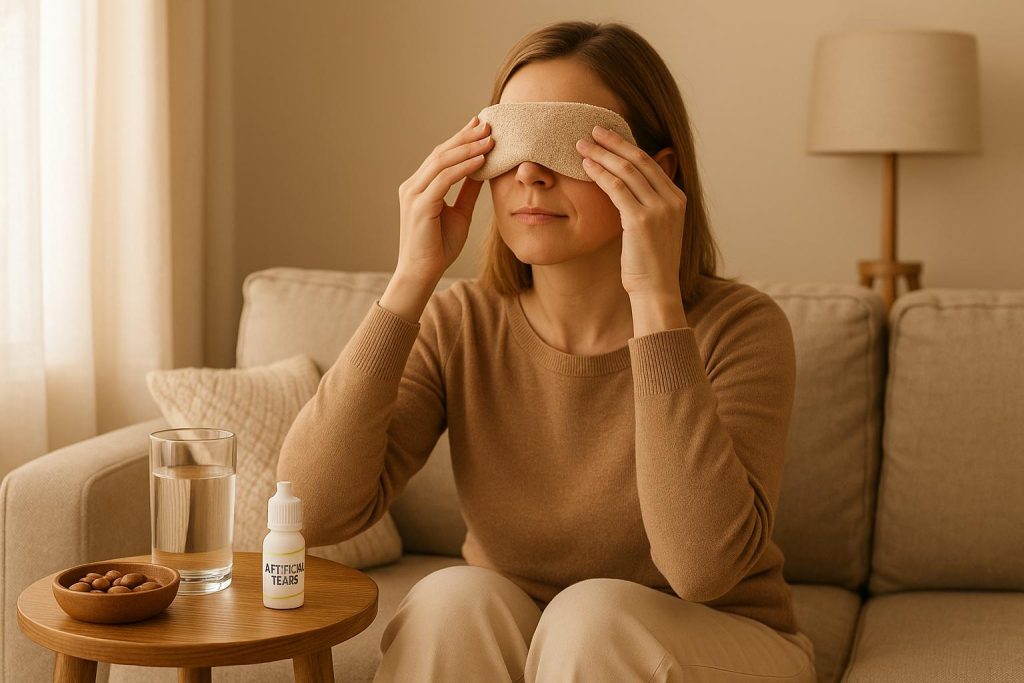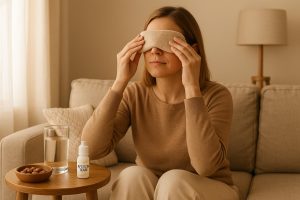Dry eyes can be uncomfortable and even lead to long-term issues if untreated. Whether caused by insufficient tears, rapid evaporation, or indoor conditions, you can manage symptoms effectively at home. Here’s how:
- Artificial Tears: Use preservative-free eye drops for gentle, frequent hydration.
- Warm Compresses: Apply heat to your eyelids to unblock oil glands and improve tear stability.
- Control Indoor Air: Use a humidifier and reduce direct airflow to prevent tear evaporation.
- Screen Breaks: Follow the 20-20-20 rule to reduce strain and blink more often.
- Omega-3 Fatty Acids: Add fatty fish or supplements to your diet to support tear quality.
These solutions, when used consistently, can ease discomfort and protect your eye health. If symptoms persist, consult a professional.
Best Dry Eye Treatments at Home | Simple & Effective | Step by Step Guide | Eye Surgeon Explains
Use Artificial Tears and Lubricating Eye Drops
Artificial tears are a common go-to remedy for managing dry eye symptoms. These over-the-counter drops work by supplementing your natural tears, offering quick hydration and relief. But choosing the right type and using them properly makes all the difference.
Pick the Right Eye Drops
When browsing for artificial tears, you’ll come across two main types: regular drops with preservatives and preservative-free options. If you’re dealing with dry eyes, preservative-free drops are often the better choice.
Regular drops contain preservatives like benzalkonium chloride (BAK), which help extend shelf life but can irritate your eyes or even worsen symptoms over time. On the other hand, preservative-free drops are packaged in single-use vials or specially designed multi-dose bottles that minimize contamination. While these are typically more expensive and slightly less convenient, they’re gentler on sensitive eyes and safer for those with severe dry eye.
Research shows that preservative-free formulations can significantly reduce symptoms without causing unwanted side effects. If you have sensitive eyes, have had allergic reactions to eye drops, or regularly use prescription eye medications, preservative-free drops are a safer bet.
How to Use Eye Drops Correctly
How often you use artificial tears depends on the type of drops you choose. Drops with preservatives shouldn’t be used more than four times a day. If you find yourself needing relief more frequently, it’s time to switch to preservative-free options, which can be used as often as needed.
To apply eye drops correctly, follow these steps:
- Tilt your head back and gently pull down your lower eyelid to create a small pocket.
- Squeeze one drop into the pocket without letting the dropper tip touch your eye or eyelid to avoid contamination.
- Close your eyes for about 30 seconds to help the drop spread evenly across your eye.
If you’re using prescription eye drops along with artificial tears, wait 5–10 minutes between applications to ensure each product works as intended. Always follow your optometrist’s instructions for prescription medications and consult them if you’re unsure about your routine.
Apply Warm Compresses
Warm compresses can ease dry eyes by promoting better oil secretion from your eyelids. This simple heat therapy addresses some of the root causes of dry eyes by improving the oil flow that helps maintain a healthy tear film.
Steps for Applying Warm Compresses
Here’s how to use warm compresses effectively. Start by soaking a clean washcloth in warm water. The recommended temperature range is 104°F to 113°F (40°C to 45°C) – a level that is both safe and effective. Wring out any excess water and test the cloth on your wrist to ensure it feels comfortably warm. Place the warm cloth over your closed eyelids and relax for about 5 to 6 minutes. Repeat this process two to three times daily, ideally incorporating it into your morning and evening routines.
Why Warm Compresses Help
The effectiveness of warm compresses lies in their ability to tackle one of the most common causes of dry eyes. Evaporative dry eye accounts for nearly 85% of all dry eye cases. This condition occurs when tears evaporate too quickly due to insufficient protective oils. Tiny meibomian glands in your eyelids are responsible for producing these oils, but when these glands become blocked or stop working properly – a condition called meibomian gland dysfunction – your tears lose this vital oil layer.
Warm compresses work by opening up these blocked glands, allowing them to release the oils needed to stabilize your tear film. They also help clear away debris and other blockages, improving gland function.
Dr. Thelma Barnes, an ophthalmologist at Mayo Clinic, explains the process:
"By unplugging any plugged oil gland pores on the eyelid margins, oil from the eyelid can freely glide over the surface of your eye to form a protective layer – much like a sheen of oil sometimes can be seen in parking lot puddles after rain. This can take a few days to benefit you, and it keeps your tears from evaporating so quickly."
In addition to restoring oil flow, warm compresses provide soothing moisture and heat that can stimulate tear production and reduce discomfort. After treatment, your eyes are also better equipped to flush out debris and bacteria, promoting healthier eyes overall.
Next, discover how managing your home’s humidity can further enhance eye comfort.
Control Home Humidity and Air Quality
The environment inside your home has a big impact on eye comfort. Dry indoor air speeds up tear evaporation, which can make symptoms worse. Striking a balance with indoor moisture levels and reducing direct airflow can help protect your eyes’ tear film.
Set Up a Humidifier
Adding moisture to the air is a simple and effective way to ease dry eyes at home. Keeping humidity levels between 40% and 60% can slow down tear evaporation and provide noticeable relief.
To monitor these levels, use a hygrometer. Once you’ve got the right humidity, it’s easier to limit direct air exposure, which is another key step.
Humidifiers can be beneficial year-round, especially since heating and air conditioning can dry out the air. Use distilled water in your humidifier to avoid adding unwanted chemicals or debris to the air. Also, clean the device regularly with distilled water to prevent bacteria from growing.
Keep Air Away from Your Eyes
Even with proper humidity, direct airflow can dry out your eyes quickly. Air conditioning, in particular, reduces humidity and speeds up tear evaporation.
To avoid this, position fans and vents so they don’t blow directly on your face or where you sit most often. For example, adjust air conditioning vents so they don’t aim at your desk, favorite chair, or bed. This simple step can help protect your eyes from drying out.
If you work from home, think about how your workspace is set up. Avoid placing your computer near air conditioning vents or heaters, and try to keep the temperature settings moderate so the system doesn’t run constantly. In rooms where airflow can’t be redirected, oscillating fans can be a better option than stationary ones.
Finally, keep your home’s ventilation system in good shape. Change filters in heating and cooling systems regularly to maintain clean air circulation. On days when the outdoor air quality is good, open windows and doors to let in fresh air without depending entirely on mechanical systems.
sbb-itb-d13af49
Take Screen Breaks and Follow the 20-20-20 Rule
Managing indoor humidity is great for your eyes, but reducing screen strain is just as important. Spending hours staring at digital screens can lower your natural blink rate, leaving your eyes feeling dry and overworked. Regular screen breaks can ease these issues and work hand-in-hand with other remedies you use at home.
How the 20-20-20 Rule Works
The 20-20-20 rule is simple: every 20 minutes, take a break by focusing on something at least 20 feet away for 20 seconds. This small habit offers your eyes a chance to relax and recover. Research from a study of university students in Malaysia revealed that nearly 90% experienced symptoms of Computer Vision Syndrome after just two hours of continuous computer use. To make this rule part of your daily routine, set a timer or use a reminder app on your phone or computer. When it alerts you, shift your gaze to something far away, like a tree or a building. Pairing these breaks with blinking exercises can further help your eyes stay hydrated.
Practice Blinking Exercises
Blinking exercises are a great way to boost tear production and keep your eyes moist. Here’s a simple plan: every 20 minutes, after following the 20-20-20 rule, close your eyes slowly, hold them shut for 2 seconds, and then open them. Repeat this 15 times, at least three times a day. Studies show that people with dry eye symptoms who regularly practiced blinking exercises noticed improvements.
"Blinking helps to spread tears over the surface of the eyes, keeping them moist and reducing dryness. Blink frequently when using screens to prevent dry eyes."
- Superior Eye Care Tips
Professor James Wolffsohn, Head of Aston University‘s School of Optometry, recommends an effective routine: close your eyes, squeeze them shut, and reopen them, repeating the process 15 times, three times a day. It takes just three minutes but can make a big difference.
Add Omega-3 Fatty Acids to Your Diet
Omega-3 fatty acids play a key role in reducing inflammation and improving tear quality, making them an effective addition to your efforts to manage dry eyes. By addressing inflammation from the inside, omega-3s complement other remedies you might already be using.
Studies show that women who consumed the highest amounts of omega-3 fats from fish had a 17% lower risk of developing dry eyes. For the best results, focus on omega-3 sources with a high EPA to DHA ratio, as this combination is particularly effective in reducing inflammation.
Unfortunately, most people don’t meet the WHO-recommended daily intake of 0.25–2 grams of omega-3s. To bridge this gap, eating two servings of fatty fish each week is a simple and practical step.
Foods High in Omega-3s
Fatty fish like salmon, mackerel, sardines, and herring are excellent sources of EPA and DHA. Aim for at least two servings per week to support your eye health [42, 43].
That said, getting enough omega-3s solely from food can be tricky. For example, to hit 1,000 mg of combined EPA and DHA, you’d need to eat about 5 servings of salmon, 27 servings of tuna, or 35 servings of haddock weekly. While two servings of fatty fish per week is a great start, you might still need to explore other options.
For vegetarians and vegans, plant-based sources like flaxseeds, chia seeds, and walnuts provide ALA, a type of omega-3. However, the body converts less than 5% of ALA into the EPA and DHA needed for eye health, making these sources less efficient [40, 41, 48].
| Food Source | Omega-3 Type | Weekly Recommendation | Notes |
|---|---|---|---|
| Salmon, mackerel, sardines | EPA & DHA | 2 servings | Best for dry eyes |
| Flaxseeds, chia seeds | ALA | Daily small amounts | Limited conversion |
| Walnuts | ALA | 1 oz (about 14 halves) | Plant-based alternative |
Should You Take Supplements?
If your diet falls short, omega-3 supplements can help fill the gap. Before starting any supplements, consult your doctor to ensure they’re right for you.
The FDA advises keeping daily omega-3 intake below 3,000 mg of combined EPA and DHA, with no more than 2,000 mg coming from supplements. Exceeding these levels could lead to side effects like bleeding or other complications.
For better absorption, choose triglyceride-form omega-3 supplements. A 4:1 EPA to DHA ratio is often recommended for dry eye relief. Always check labels for third-party testing and consider formulas with vitamin E to maintain freshness.
Taking omega-3 supplements with a meal that contains fat can improve absorption. Be mindful of expiration dates and potential mild side effects, such as a fishy aftertaste, bad breath, heartburn, nausea, or diarrhea. If over-the-counter options aren’t effective, prescription omega-3 products, monitored by the FDA, may be worth discussing with your healthcare provider.
Adding omega-3s to your routine, whether through food or supplements, works alongside external treatments to manage dry eyes. It also helps balance the typical Western diet, which tends to be heavy in omega-6 fats that can worsen inflammation. Incorporating more omega-3s supports not just your eyes but your overall health strategy.
Conclusion
Taking care of dry eyes at home can be manageable with a combination of remedies like artificial tears, warm compresses, humidity control, regular screen breaks, and omega-3 supplements. The trick is to use these methods consistently over time, as relying on just one approach might not be enough for lasting relief.
"Home therapies are a key part of the success of a dry eye treatment plan, so you have to do your part for it to work well. You may feel better right away, or it may take a couple months to get noticeable and lasting relief. Be persistent and follow through, and it will pay off."
Tracking your progress is just as important. If you don’t see improvement after a few weeks of using over-the-counter drops and home remedies, or if your symptoms worsen, it’s time to consult a professional. Don’t ignore signs like new side effects or if dry eyes start interfering with your daily life [2, 53].
Early intervention matters – a delay in treatment could lead to long-term damage to your eyes. Considering that over 50 million Americans deal with chronic dry eye symptoms, you’re far from alone in this experience.
"There are so many patients who have dry eye, and we have a variety of treatments to offer." – Kourtney Houser MD, Corneal Specialist at Duke Health
If your symptoms persist despite these efforts, Windsor Eye Care & Vision Center can offer a professional evaluation and personalized treatment options. While many people find relief through home care, ongoing attention is often necessary to manage this condition effectively.
FAQs
What should I consider when choosing artificial tears for dry eyes?
When choosing artificial tears, consider how often you’ll need them and what suits your eyes best. If you plan to use them frequently, preservative-free drops might be a better choice, as preservatives in some formulas can lead to irritation with repeated use. For longer-lasting comfort, high-viscosity drops are worth exploring, though they might cause temporary blurriness. If your dry eye symptoms are more severe, oil-based drops can provide extra moisture, but they aren’t recommended if you wear contact lenses.
Since every individual’s eyes are unique, it might take some trial and error to find the most effective option. If your symptoms don’t improve or get worse, it’s a good idea to reach out to your eye care provider for tailored guidance.
How can I safely use a warm compress to relieve dry eyes?
To use a warm compress safely for dry eyes, start by soaking a clean washcloth in warm (not hot) water to avoid burns. Wring out the extra water and place the cloth gently over your closed eyelids. Leave it there for about 5 to 10 minutes, re-soaking it as needed to maintain the warmth. Doing this once or twice a day can provide relief.
If you’re looking for a more convenient option, consider using heated eye masks or reusable compresses that maintain a steady warmth. Just make sure the temperature feels comfortable and isn’t too hot to protect both your skin and eyes.
How do omega-3 fatty acids help improve dry eye symptoms?
Omega-3 fatty acids play an important role in easing dry eye symptoms. They work by reducing inflammation and enhancing the quality of your tear film. Specifically, they help your tears retain moisture by supporting the production of healthy oils, which slows down evaporation.
Incorporating omega-3s into your diet – whether through foods like salmon, walnuts, and flaxseeds, or through high-quality supplements – can lead to noticeable improvements in eye comfort. Many individuals experience relief after consistently consuming omega-3s for about 6 to 12 weeks.




